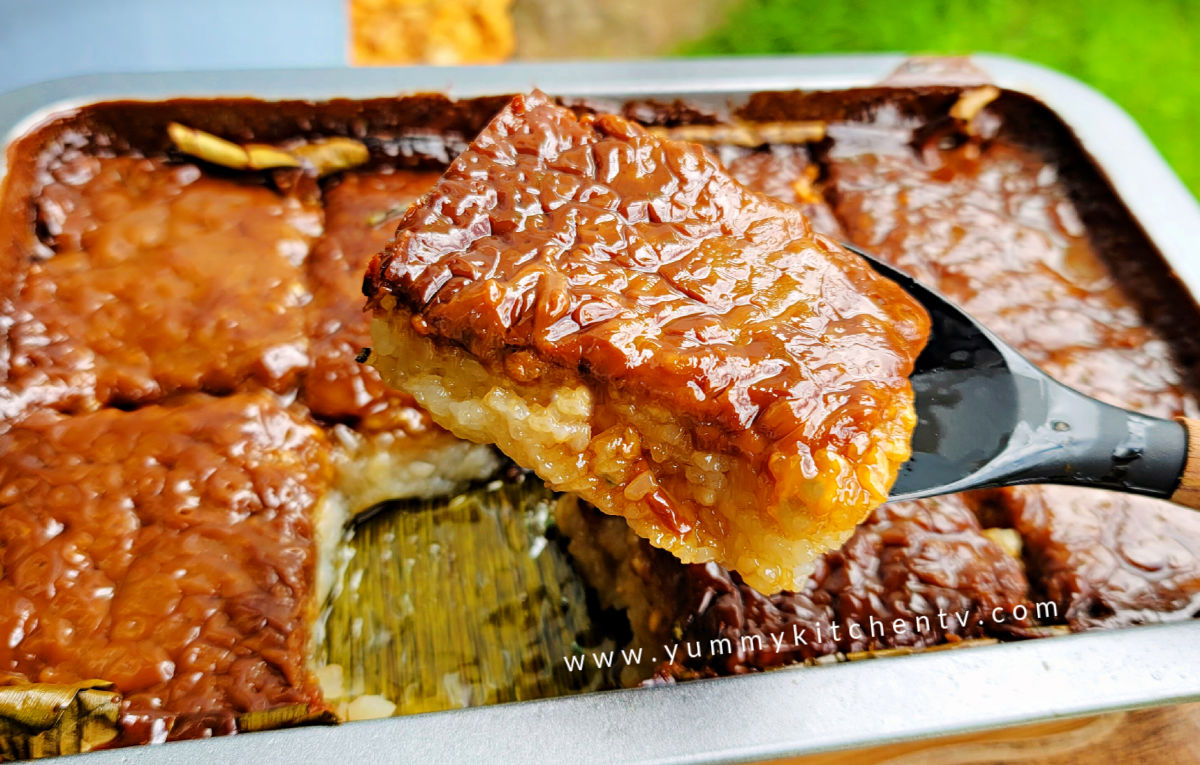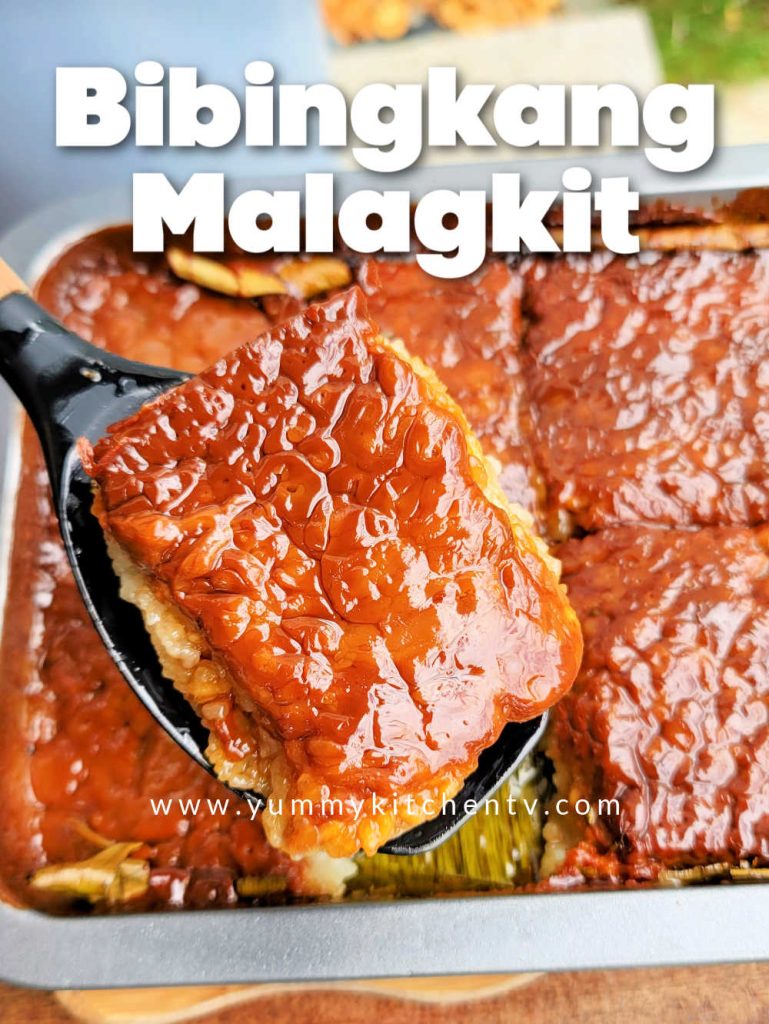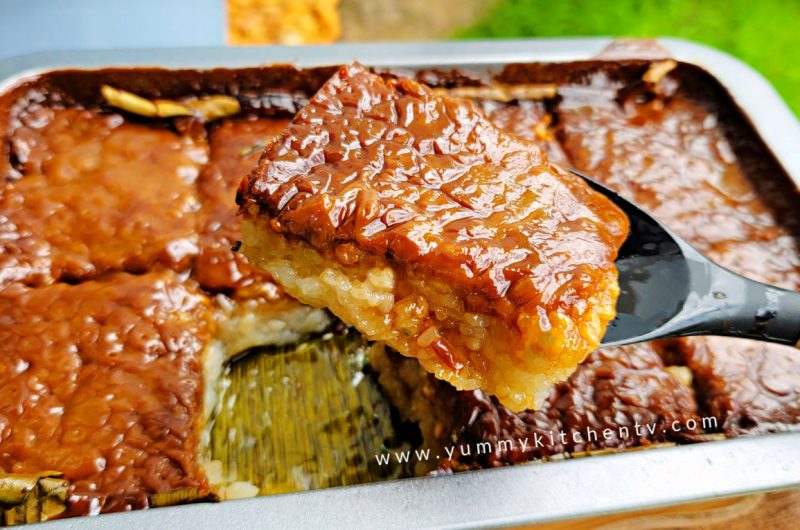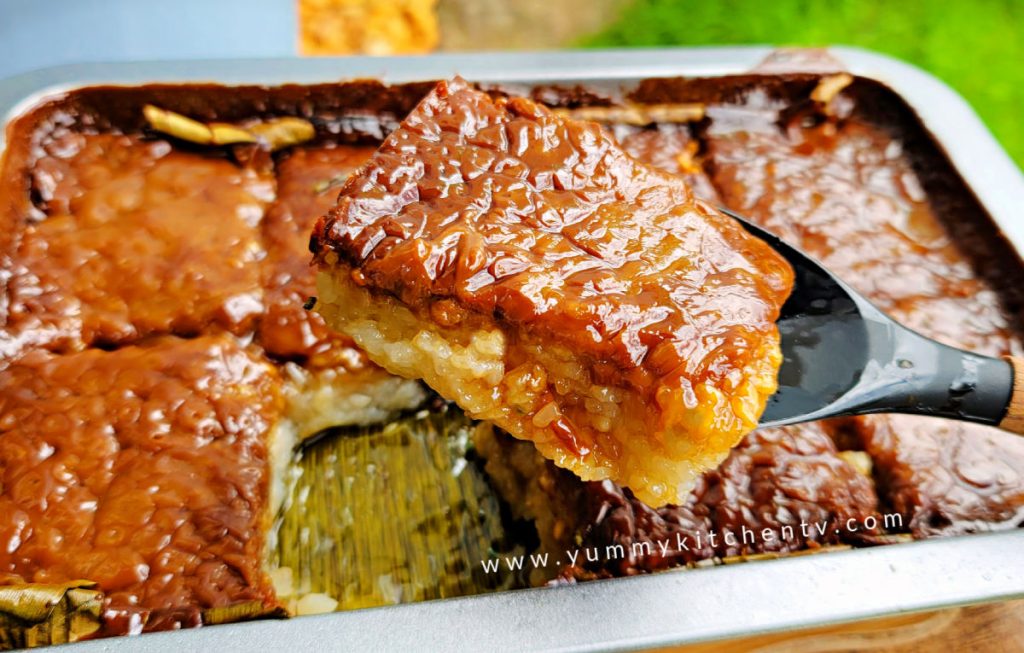Bibingkang malagkit, a Filipino sticky rice cake, made from glutinous rice cooked with coconut milk and sugar, is a traditional Filipino delicacy that holds a special place in Filipino cuisine. This rich and sticky treat is a heavenly combination of sweet and creamy flavors, with a chewy and sticky texture that is truly indulgent. Each bite offers a delightful harmony of coconut-infused rice and the subtle sweetness that will surely captivate your taste buds.
Bibingkang Malagkit Recipe
Ingredients:
For the Rice:
- 2 cups glutinous rice
- 3 cups coconut milk
- 1/2 cup sugar
- 1/2 teaspoon salt
For the Latik:
- 2 cups coconut milk
- 1 1/2 cup brown sugar
Directions:
- Prepare the glutinous rice and wash them multiple times. Set aside.
- Prepare a pan. Add the coconut milk, sprinkle some salt and stir a bit. Heat the pan and wait for it to boil.
- Once boiling, add the washed glutinous rice. Let this cook using low heat until the grains absorb the coconut milk. Stir occasionally to cook it evenly and to prevent burning.
- Once the rice is cooked and sticky, add the sugar. Stir continously until the rice becomes stickier and has absorbed all the coconut milk.
- Prepare a serving pan and line it with banana leaves. Pour the rice mixture in the pan and flatten the top using a spatula. Set aside.
- For the latik, place the coconut milk and brown sugar in a pot. Mix well and heat the pan. Stir continuously to avoid burning. Allow this to cook using low heat until thick and sticky. Once thickened, pour the latik mixture immediately over the cooked rice.
- Bake the bibingka in a pre-heated oven for 45 minutes at 160 C.
- After 45 minutes, let the bibingka cool a bit and set before slicing into serving pieces.
What is Bibingka
The name “bibingkang malagkit” is derived from the Filipino word “malagkit,” which means sticky or glutinous. This dessert is a popular choice during special occasions and festive celebrations, such as Christmas and fiestas. It is often enjoyed as a delightful merienda (snack) or as a dessert after a satisfying meal.
Bibingka is a traditional Filipino rice cake that is popularly enjoyed during the Christmas season and other festive occasions. It is a beloved dessert that has a special place in Filipino cuisine. The batter is poured into specially designed clay pots or banana leaf-lined molds, giving it a distinct round shape. It is traditionally cooked over hot coals or in an oven until it becomes soft, moist, and slightly charred on the edges.
The texture of bibingka is unique and delightful. It is dense, moist, and has a slightly chewy consistency. The flavor profile is subtly sweet, with a hint of coconut flavor from the coconut milk used in the batter. The topping of bibingka is what sets it apart and adds an extra layer of deliciousness. Common toppings include grated coconut, butter or margarine, salted egg slices, and sometimes even cheese.
Bibingka is typically served hot and enjoyed with a cup of hot chocolate or coffee, especially during the Christmas season. It is a comforting and satisfying treat that brings people together, fostering a sense of joy and togetherness during festive celebrations.
While bibingka is traditionally associated with Christmas, it is also available throughout the year in various local bakeries and food stalls in the Philippines. Its timeless appeal and delectable taste continue to make it a favorite among Filipinos and a delightful introduction to the country’s rich culinary heritage.
What is Malagkit or Glutinous Rice
Glutinous rice, also known as sticky rice or sweet rice, is a type of rice that is widely consumed in various Asian cuisines, including in countries like Thailand, Japan, China, and the Philippines. Despite its name, glutinous rice does not contain gluten and is safe for those with gluten-related dietary restrictions.
What sets glutinous rice apart from other types of rice is its sticky and chewy texture when cooked. It has a higher starch content and different molecular structure compared to regular rice, which gives it its characteristic stickiness. When cooked, the grains of glutinous rice tend to cling together, creating a cohesive and slightly sticky consistency.
Bibingkang Malagkit
Just like any other kakanins, bibingkang malagkit is one of my favorite to have alongside my tea of coffee in the afternoon. Unlike the common bibingka, the bibingkang malagkit is much easier to make with only minimal ingredients.
Because of its simplicity to make, some children are selling bibingkang malagkit for 5 pesos a slice. I loved it! But this 5-peso slice is really thin, which made me think of making my own to share for the whole family.
What I love about bibingkang malagkit is that it is is thick and sweet, we can easily enjoy it as a slice rather than other sweet dishes like ginataang balatong and champorado. With just glutinous rice, coconut milk and brown sugar, we can create a very filling snack that can help us through the day.
If you wanna know how to make bibingkang malagkit, read and follow the easy steps below. Happy cooking
How to Cook Bibingkang Malagkit
The bibingkang malagkit, just like any other kakanin, is super easy to make. The two main parts of this kakanin is the rice and the latik which are both super easy to make.
Lets start with the rice. Unlike the regular rice which we use to have with our savory ulam, kakanins like this bibingka uses glutinous rice or malagkit na bigas, so be sure to get the correct rice grains. The grains of the glutinous rice appears more round and smaller than the regular grains. Cooking this type of rice uses more water compared to when cooking regular rice.
Before we start, wash the glutinous rice grains first. This is to remove the excess starch which sticks to the grains. I always wash around 2 to 3 times. You dont need to wash the rice until the water is very clear. A little cloudy water is already good.
Instead of water, we will use coconut milk to cook the rice. This is to make sure that our rice base will be creamy and naturally tasty. Since the coconut milk is prone to burning, use low heat for this step. It may take a lot of minutes for the rice grains to fully absorb the rice so just keep stirring. Once you feel the rice is cooked and the coco milk has been fully absorbed, do a taste test just to check if the rice was really cooked and soft. When the rice is ready, simply transfer to an oven-safe pan, lined with banana leaves for some added aroma.
Now for the latik, we will be making the syrup one instead of the bits. This latik can ba made by just combing coconut milk and brown sugar and cook until thick like a syrup. Take note that you need to use brown sugar for this latik recipe to be extra tasty. Using white sugar might cause a difference. Brown sugar adds a “caramel” hint to the taste of the latik. Once you have mixed the coconut milk and brown sugar, it will take a few minutes before the consistency of the latik to be thick. Make sure to keep stirring to prevent burning. Once you achieve the right thickness, pour the latik sauce over the cooked rice.
Some bibingkang malagkit stops at this point and just let the dish cool a little before serving. But of course, we always take an extra step to make sure that our dishes are extra special. So for this recipe, we are going to bake the bibingkang malagkit in an oven for 45 minutes. This is to let the latik to set fully on top of the rice. You will also notice the unique fragrance of the latik sauce which fully achieved its caramel flavor. After baking, there will be a lot of bubbles from the latik sauce. Just cool the bibingka a bit before slicing and serving.
I like to enjoy my bibingkang malagkit with my favorite afternoon tea or coffee. Since the bibingka is already sweet, then there is no need for me to add sugar to my hot drink. Yum!
Bibingkang Malagkit
Course: Desserts, Filipino Recipes6
servingsIngredients
- For the Rice:
2 cups glutinous rice
3 cups coconut milk
1/2 cup sugar
1/2 teaspoon salt
- For the Latik:
2 cups coconut milk
1 1/2 cup brown sugar
Directions
- Prepare the glutinous rice and wash them multiple times. Set aside.
- Prepare a pan. Add the coconut milk, sprinkle some salt and stir a bit. Heat the pan and wait for it to boil.
- Once boiling, add the washed glutinous rice. Let this cook using low heat until the grains absorb the coconut milk. Stir occasionally to cook it evenly and to prevent burning.
- Once the rice is cooked and sticky, add the sugar. Stir continously until the rice becomes stickier and has absorbed all the coconut milk.
- Prepare a serving pan and line it with banana leaves. Pour the rice mixture in the pan and flatten the top using a spatula. Set aside.
- For the latik, place the coconut milk and brown sugar in a pot. Mix well and heat the pan. Stir continuously to avoid burning. Allow this to cook using low heat until thick and sticky. Once thickened, pour the latik mixture immediately over the cooked rice.
- Bake the bibingka in a pre-heated pan for 45 minutes at 160 C.
- After 45 minutes, let the bibingka cool a bit and set before slicing into serving pieces.
Paano Magluto ng Bibingkang Malagkit
Mga Sangkap:
Para sa Kanin:
- 2 tasang malagkit na bigas
- 3 tasang gata
- 1/2 tasang asukal
- 1/2 kutsaritang asin
Para sa Latik:
- 2 tasang gata
- 1 1/2 tasang asukal na pula
Paano Lutuin:
1. Ihanda ang malagkit na bigas at hugasan ito ng ilang beses. Isantabi.
2. Ihanda ang kawali at ilagay dito ang gata. Budburan ng konting asin at haluin. Lutuin ito hanggang kumulo.
3. Kapag kumukulo na, saka ilagay ang malagkit na bigas. Hayaan itong maluto gamit ang mahinang apoy hanggang ma-absorb ng mga bigas ang gata. Haluin ito para maging pantay ang luto at hindi masunog.
4. Kapag malagkit na ang bigas, ilagay na ang asukal. Haluin lang ito ng tuloy tuloy hanggang mas lalong maging malagkit at maiga ang lahat ng gata ng niyog.
5. Lagyan ng dahon ng saging ang baking pan. Ilagay ang nalutong malagkit at pantayin. Itabi muna.
6. Lutuin ang latik. Pagsamahin ang asukal at kakang gata sa isang pan. Lutuin sa mahinang apoy hanggang sa lumapot. Kapag malapot na, ibuhos sa ibabaw ng nalutong bigas malagkit.
7. I-bake sa mainit na oven ng 45 minuto hanggang isang oras na may temperature na 160C.
8. Kapag na-bake na, palamigin lang muna ng kaunti bago ihain. Enjoy!






